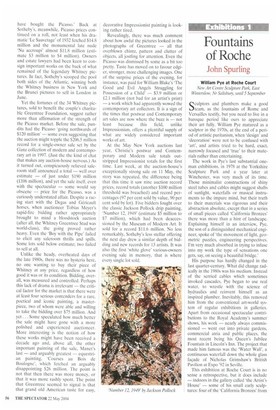Easing out the Impressionists
Susan Moore
A $100 million Picasso casts a surprisrAingly long shadow. Before the sale of 'Garcon a la Pipe (le jeune apprenti)' at Sotheby's New York on 5 May for a record-breaking $104 million (£58 million), the sole subject of conversation of the entire art world seemed to be whether the late Mr and Mrs John 'Jock' Hay Whitney's rare Rose Period masterpiece would topple the world auction record price set in 1990 when Van Gogh's 'Portrait of Dr Gachet' fetched $82.5 million. No less significantly, would it — could it — be the first work of art to break the $100 million threshold?
At the Christie's sale the preceding evening, it was as if no one was really paying attention — though those with their eye on the ball contributed to new auction records for Giorgio de Chirico ($7 million), Odilon Redon ($3.8 million) and for the 'Art Deco Icon' Tamara de Lempicka an astounding $4.6 million (that's fashion for you). At the gala opening of the International Fine Art Fair at the Seventh Regiment Armory the following evening, the turnout looked sparser than usual. As one dealer sighed, 'Everyone thinks they have bought the Picasso.' Back at Sotheby's, meanwhile, Picasso prices continued on a roll, not least when his dramatic 'Le Sauvetage' of 1932 fetched $14.8 million and the monumental late nude *Nu accroupi' almost $11.8 million (estimate $3 million to $4 million). Owners and estate lawyers had been keen to consign important works on the back of what remained of the legendary Whitney pictures. In fact, Sotheby's scooped the pool both sides of the Atlantic, winning both the Whitney business in New York and the Brunei pictures to sell in London in June.
Yet the fortunes of the 34 Whitney pictures, sold to benefit the couple's charitable Greentree Foundation, suggest rather more than affirmation of the strength of the Picasso market. Before the sale, pundits had the Picasso 'going northwards of $120 million' — some even suggesting that the auction might topple the $206.5 million record for a single-owner sale set by the Ganz collection of modern and contemporary art in 1997. (Just the the kind of chat that makes any auction-house nervous.) As it turned out, conspicuously relieved saleroom staff announced a total — well over estimate — of just under $190 million (106 million), and yet the sale itself, even with the spectacular — some would say obscene — price for the Picasso, was a curiously understated affair. Despite a racing start with the Degas and Gericault horses, when auctioneer Tobias Meyer's rapid-fire bidding rather appropriately brought to mind a bloodstock auction (after all, the Whitney Greentree Stud was world-class), the going proved rather heavy. Even the 'Boy with the Pipe' failed to elicit any saleroom thrills and spills. Some lots sold below estimate; two failed to sell at all.
Unlike the heady, overheated days of the late 1980s, there was no hysteria here, no one wanting to buy their piece of Whitney at any price, regardless of how good it was or its condition. Bidding, overall, was measured and controlled. Perhaps this lack of drama is irrelevant — the critical factor for the market is that there were at least four serious contenders for a rare. poetical and iconic painting, a masterpiece, two of whom were able and willing to take the bidding over $75 million. And yet ... Some speculated how much better the sale might have gone with a more polished and experienced auctioneer. More interesting is the notion of how these works might have been received a decade ago and, above all, the other important painting of the sale, Manet's last — and arguably greatest — equestrian painting. 'Courses au Bois de Boulogne', which fetched an arguably disappointing $26 million. The point is not that then there was more money, or that it was more rashly spent. The point that Greentree seemed to signal is that that grand old American taste for easy, decorative Impressionist painting is looking rather tired.
Revealingly, there was much comment about how awful the pictures looked in the photographs of Greentree — all that overblown chintz, pattern and clutter of objects, all jostling for attention. Even the Picasso was dismissed by some as a bit too pretty. Taste has moved on to favour edgier, stronger, more challenging images. One of the surprise prices of the evening, for instance, was paid for William Blake's 'The Good and Evil Angels Struggling for Possession of a Child' — $3.9 million or £2.1 million (not bad for an artist's print) — a work which had apparently wowed the contemporary art collectors. It is a sign of the times that postwar and Contemporary art sales are now where the buzz is — not least because this field, unlike Impressionism, offers a plentiful supply of what are widely considered important works of art.
At the May New York auctions last year, Christie's postwar and Contemporary and Modern sale totals outstripped Impressionist totals for the first time. Last week, at the auction-house's exceptionally strong sale on 11 May, the story was repeated, the difference being that this time it saw nine auction record prices, record totals (another $100 million threshold was breached) and record percentages (97 per cent sold by value, 90 per cent sold by lot). Five bidders fought over the classic Jackson Pollock drip painting, 'Number 12, 1949' (estimate $5 million to $7 million), which had been deaccessioned by the Museum of Modern Art. It sold for a record $11.6 million. No less remarkably, Sotheby's less stellar offering the next day drew a similar depth of bidding and new records for 13 artists. It was also the first 'white glove' various-owners evening sale in memory, that is where every single lot sold.



















































































 Previous page
Previous page